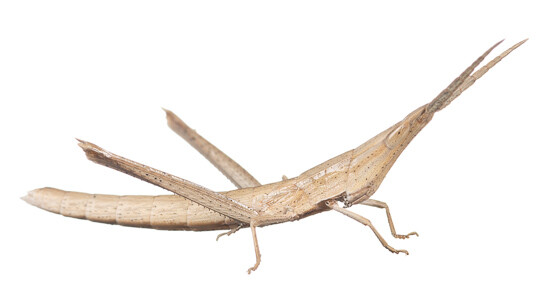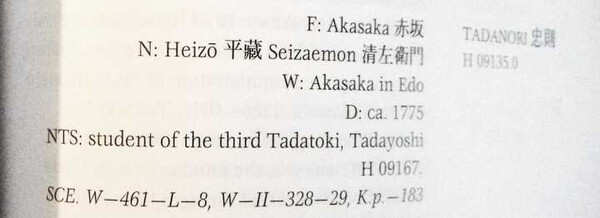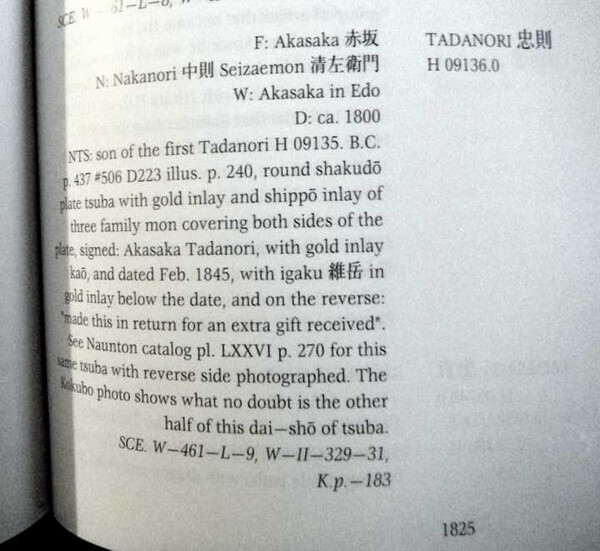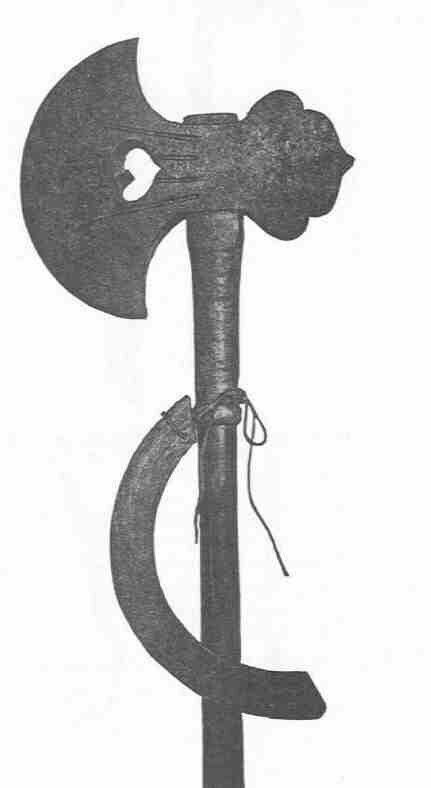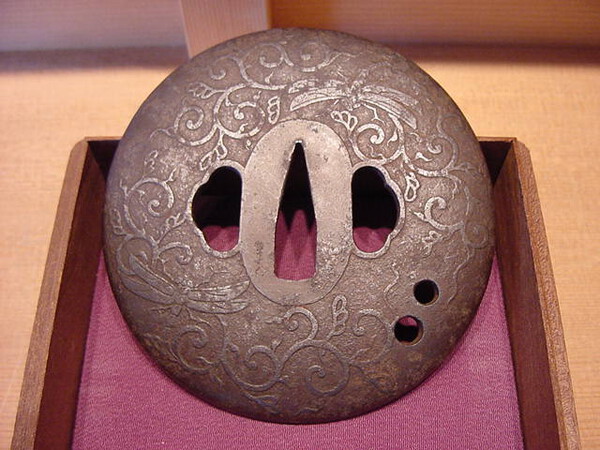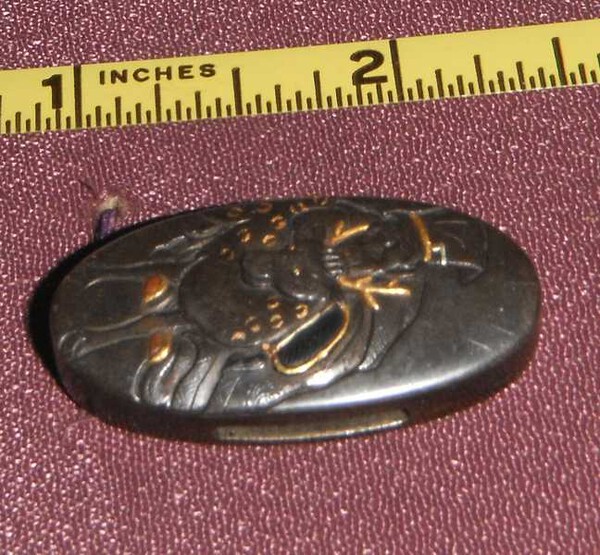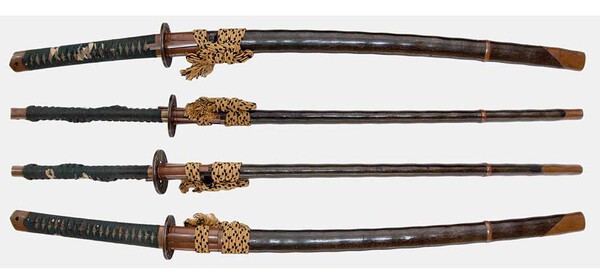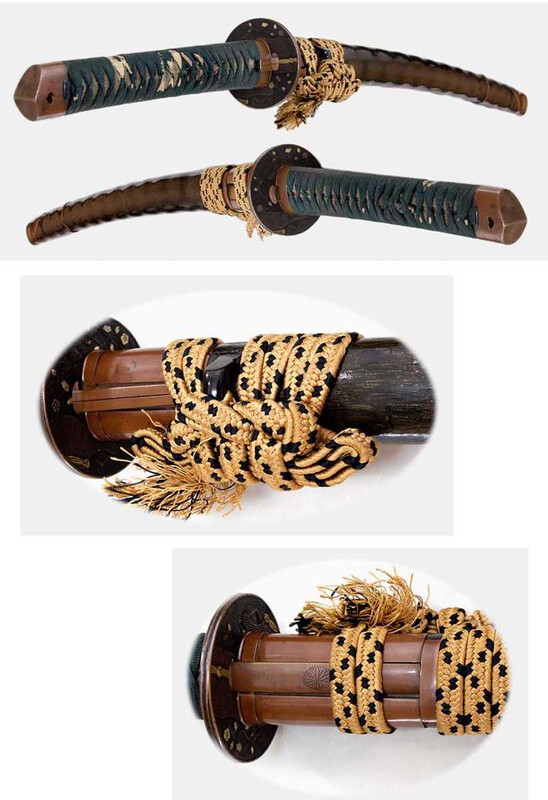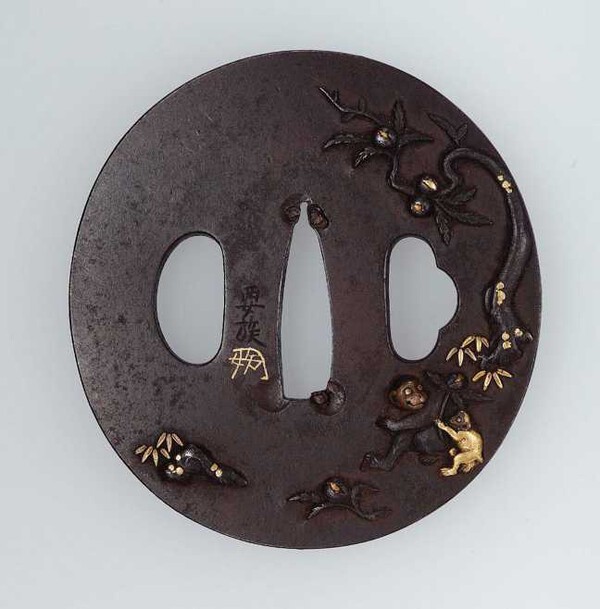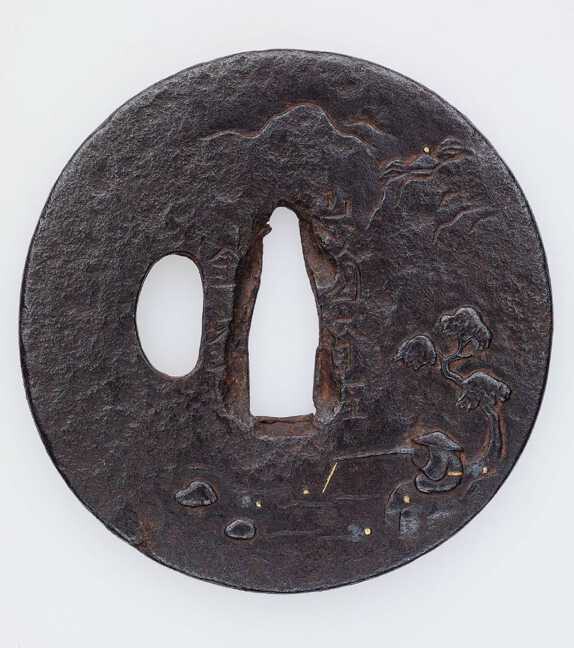-
Posts
435 -
Joined
-
Last visited
Content Type
Profiles
Forums
Events
Store
Downloads
Gallery
Everything posted by Lance
-
Looks like Curran beat me to it: I'd also look into Heianjo school, age somewhere around Muromachi/Momoyama period: 1500 to early 1600's. From your pictures it appears to have a fukurin (soft metal rim)? The size of the tang opening and the way the design runs off the edge, along with the patina of the iron and overall "feel" of it (To me) points to an older guard that was made smaller and a fukurin added decades to 100(s) of years later. Like swords sometimes tsuba would be altered by an new owner, resizing, adding a rim, or whatever else depnding on their needs or wants, taste, sentimental reasons, etc. Hope this is of some use, Regards, Lance
-
I agree the front is a mantis, I just figured I'd mention it. From a condition standpoint I would imagine a grasshopper with a long head is better news than an insect missing it's head. (even if it is a mantis ) Regards, Lance
-
I don't think the insect with the missing head on the reverse of Piers's tsuba is a mantis, looks to be a species of long headed grasshopper? http://bugguide.net/node/view/4400/bgimage Regards, Lance
-
Below's a link to another example with the same theme signed Tadanori Tetsugendo.com, I can't make out the kanji on the tsuba though, maybe you can contact Mike Yamasaki for a clearer image of the mei on his tsuba? It's listed as having Hozon papers so it could make for a good comparison. http://tetsugendo.com/kodogu/FT-179_Aka ... anori.html Your tsuba does look to be later, maybe late Edo, Hayne's index has 2 Akasaka Tadanori, maybe your's is the 2nd? (pics below) Hope this is of some use. Regards, Lance
-
Not sure if you saw the site linked below already: but lots of the same items, searchable and close-ups too. http://www.mfa.org/search/collections?k ... %20kashira Regards, Lance
-
Not to say koshi-zori weren't made during Muromachi period, (always exceptions) just that the suirage done on this example can be a possibility in explaining the shape. Since the blade was shortened, and it looks like the first hamachi was probably around 3-4 inches above the lowest (pluggged) hole and mei, before alterations the largest area of sori would have been nearest the center, so originally created as tori-zori? Also when the nakago was reshaped, it looks like the mune side was shaved down, "pulling" the signature closer to that side? (seems like more care was taken with this than some other suirage with a kiri end usually seen) Regards, Lance
-
Below is an image and a link pic from another site. Looks like a real example, but it doesn't mention what book it came from. http://www.e-budo.com/forum/showthread. ... -Axe/page2 I used to have a small collection of old auction catalogs that I gave away, one had what was described as a late Edo/Meiji presentation/gift. From what I remember it was identical in shape, but much more elaborate: black lacquered handle with metal fittings and kanji in red lacquer on the blackened axe head in a wooden box. I'm surprised at how rare these are, maybe they discarded because they weren't considered "true samurai" weapons or too utilitarian during the more peaceful Edo times? Regards, Lance
-
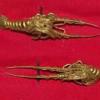
Katana ageschool/possible tsuba maker respectfully requested
Lance replied to gun addict's topic in Nihonto
From the pics I'd say the tsuba looks to be Nobuie school/style (tortoise shell design) Edo period? Blade itself maybe Muromachi period, Bizen school from shape of blade and tang. If the hamon stops at hamachi, suggesting wasn't shortened. may have been katte-uchi one handed sword. If the hamon goes past it into the tang it would suggest being shortened. Even though extra holes were usually added due to shortening or as a reinforcement of sorts on Shinto and Shinshinto I have seen ubu Muromachi swords with an extra hole towards the end, for the most part I think the examples I've seen were all Bizen and around 22-26 inches. Hope this is useful, I'm sure someone will come along with any necessary corrections or provide more info. Regards, Lance -
The patina/condition of the tang has the appearance of what's usually seen on Showa period swords. From the file marks and end of tang in particular I'd say Seki. It's not 100% concrete but I've had or come across a surprising amount that had the same flat bit on the tip of the tang, almost all of them that were signed started with Noshu or (Seki) or had Seki stamps. My understanding is the tang and blade were formed along with the blade and attached to a rod/bar that was cut away, either just before or after hardening. The end was usually filed away as part of the finishing work, most Seki swords were more like assembly line weapons production though, so they didn't always finish their mass production swords to the same level as other groups. Regards, Lance
-
Agree about not polishing until it's looked at, appears to be Showa era (WW2) so even if it's traditionally made it might not be worth it, and $700 doesn't seem like you'd get a very good polish either. Is the club in the link below the sword group you mentioned? If so I haven't heard many positive things about them over the years. https://sites.google.com/site/sfswordsociety/ Regards, Lance
-
I'd guess later Edo period, shape looks Higo, Butterfly looks Higo style, inlay/overlay method looks similar to methods used by various Hizen/Higo schools. I like way the moon is depicted, appearing to rise out from behind the clouds at night. Also wether from wear or on purpose the uneven gold does create a decent representation of its cratered surface. Regards, Lance
-
I see, attached an image from same website of similar horimono on a sword by Tsunahiro. (whenever I think Soshu I equate with a wild hmon, and forget there are examples with suguha as well, especially later) http://www.sho-shin.com/soshu.html Is the lower hamon in area near hamachi what you were referring to when indicating space left for a horimono? Thanks, Lance
-
Although not of the same quality, this type of stylized dragon horimono has a little bit of resemblance to Heianjo Nagayoshi: link and pic below share "some" similarity (as well as tapering nakago, example shown taper is more pronounced but I've seen others less extreme) http://www.sho-shin.com/heianjo1.htm Maybe this is what whoever did this was emulating? Regards, Lance
-
Looks like John beat me too it, agree it's Kunihiro. Not familliar with the smith though. Any other pics of the of the blade/hamon? Might be helpful in gathering additional information. Regards, Lance,
-
I've often seen these tsuba with this type of relief and cupped shape referred to as Hizen tsuba rather than Namban (although Hizen tsuba term can sometimes be synonymous with Namban) quick link and pics of another example for reference from another member's site, hope he doesn't mind. http://www.legacyswords.com/fs_ant_tsuba7.htm Regards, Lance
-
Aside from use on a pole arm as Jean mentioned, I noticed one of the examples Curran posted appear to have the square ana purposely carved as part of the design at time of manufacture, instead of a later alteration (see pic below) This does give the appearance of originally being used on a European sword/rapier or capable of double duty, making it seem more "authentic" for the person buying it back then with a taste for Foreign goods during the Edo period ? Could this possibly be a reason why these square ana seem to pop up more on Namban guards than other schools? (guards altered to fit yari tanto not included, as they could be almost any school) Thanks for sharing, hope you decide to share more images! Regards, Lance
-
It is a pretty big sword, compared to the others in the pic below (same book, next page) looks like to be around 36-40 inches? Regards, Lance
-
Maybe you're referring to this photo from Fuller & Gregory's (hardcover)book, page 247 ? Depending on the height of the Sergeant in the photo, the highest peak of sword mountain on the right could be in the 6-8 foot range...... If I were there, I think I'd be like the guy in the video below Regards, Lance
-
According to Ridley Scott; Deckard was a Replicant http://news.bbc.co.uk/2/hi/entertainment/825641.stm Great movie, one of my favorites. My impression was that the implanted memories were based on Edward James Almos's character Gaff: he was the the original "bladerunner", but wasn't physically able to hunt them anymore personally due to past injuries. Always seen using a cane, and the discussion about bringing the old bladerunner out of retirement. Whenever I see that scene it looks like Gaff and the supervisor are ""in on the joke" Plus he did always seem to pop up as if he was keeping tabs on Deckard, leaving the unicorn origami, and the speech at the end about no one knows how much time they really have. To keep on topic, an interesting woodblock print of Yoshitsune encountering Heike, depicting the crabs and angry Taira spirits: http://honolulumuseum.org/art/10245 Regards, Lance
-
Probably better to judge in hand but they look (maybe) late Edo, with the patina cleaned off. Only thing that really stands out as suspicious on the tsuba below; at 7:00 there's a western style 5 pointed star over the flower blossom. I've never seen a star like this on any Edo/Meiji tsuba, looks similar to Chinese (communist) or Imperial Japanese? Regards, Lance
-

The Fuchi/Kashira Orphanage
Lance replied to Nihontocollector19's topic in Fittings/Tosogu/Kodogu/Koshirae
I'll go first, below's a Hamano or Nara shibuichi kashira with Jujurin and deer. Wakizashi or tanto sized. It would be nice to reunite or find a matching fuchi to complete the set, along with the Kozuka that came with it. Regards, Lance -
Maybe the folding mentioned "after" the plate refers to forging to a certain level: driving out impurities, homogenizing carbon content, etc. when reaching that desired point the plate was folded a final time, intentionally leaving the last fold slightly visible as an artistic touch or trademark of sorts for a particular smith or school? Regards, Lance
-

Feelings on "dressing out" a Nihonto?
Lance replied to Ken-Hawaii's topic in General Nihonto Related Discussion
Thought I'd ressurect this for a second, there was an example of a sword by Kiyondo on Aoi Arts discussed in another topic, and thought it might be a useful reference for creating a koshirae, same era and student of Kiyomaro: original source topic viewtopic.php?f=1&t=15227 Link from AOI ARTS, http://www.aoijapan.com/katanaushu-shon ... ra-kiyondo To me it seems like a very strong no-nonsense hybrid of Handachi and Toppei koshirae, not uncommon for larger than usual Late Edo period swords. Regards, Lance -
1046 – Factory iron plate 1201 – Factory plate, well forged How can I tell if factory iron plate is used and how well it was produced? Factory plate tend to be somewhat featureless as mentioned earlier, a sort of blank canvas that artists carved or added inlay to, or sometimes left plain, with no decoration at all. If finished without inlay or sukashi might look like a tosho tsuba with no "character" or signs of forging at all. Like everything else there are different levels of quality,even to what's been called factory plate, for example how well they're shaped and finished, although I think most of the finishing itself is dependent on ability of the artist who made the tsuba itself. Something that could be useful in judging quality levels can be a matter becoming familiar with the better artists of various schools and their works, and when coming across a piece from that school (or someone working in the style of) you can get a feel for what the intentions of the tsubako might have been and how successful they were. Below is a link and a picture to a Nara school tsuba, who were said to use factory plate for a base on many of their guards, this appears to be a good example of factory plate. http://www.mfa.org/collections/object/t ... tree-17128 1014 - Sand iron 1210 – Refined sand iron 1190 – Well forged sand iron When I think of well forged iron tsuba, something like Kaneie school comes to mind where the artist was able to incorporate the forging, folding and shaping into the design or actually being the design itself: http://www.mfa.org/collections/object/t ... scape-8480 1017 – Hitsuana, Higo style 1027 – Hitsuana, Jingo school, Higo style Below's a page of Higo and Hiigo Jingo tsuba, the hitsuana are pretty distinctive, usually large and oddly shaped, (If there's a way to identify Higo Sukashi tsuba by the hitsu-ana it's beyond me, I can recognize some designs as being associated with certain schools but I'm not too good with sukashi tsuba in general, especially compared to the more knowledgeable members here), http://www.silk-road.us/higo.html Hope this is of some use, I think this can end up being a very good topic, and possibly serve as a useful visual glossary in the future as well? Regards, Lance
-
I'd guess it was originaly a shira-saya of sorts that was lacquered or varnished, and had reinforcing rings and a kurikata added to make it suitable for use as a weapon, probably done in the 1800s-early 1900s? Wood doesn't look like honoki though, more like whatever was used for tanegashima (matchlock rifles) Shape of the blade and kissaki look OK to me, even in this condition still light years ahead of Chinese fakes found on Ebay. Regards, Lance


